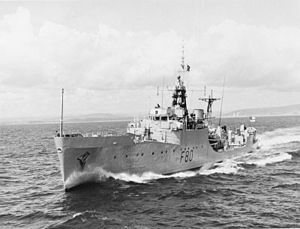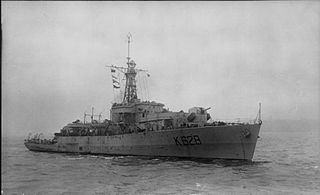
HMS Loch Killisport (K628/F628) was a Loch-class frigate of the British Royal Navy, named after Loch Killisport in Scotland. Launched in 1944, the ship was not commissioned until July 1945, and served in post-war repatriation operations in the Far East until decommissioned in April 1946. During this time Prince Philip was an officer on board this ship. Recommissioned in 1950 she served in the Home Fleet for two years, before being extensively modernised for service in the Persian Gulf and Far East. Decommissioned in August 1965, she was sold for scrapping in 1970.

HMS Andromeda was a Leander-class frigate of the Royal Navy. She was built at HM Dockyard Portsmouth. She was launched on 24 May 1967 and commissioned into the Royal Navy on 2 December 1968. She took part in the Falklands War. She was sold to India in 1995, for use as a training ship, being renamed INS Krishna. She was finally decommissioned in May 2012.

HMS Galatea (F18) was a Leander-class frigate of the Royal Navy. She was built by Swan Hunter & Wigham on the Tyne. She was launched on 23 May 1963 and commissioned on 25 April 1964 and was the eighth ship of the Royal Navy to bear the name.

HMS Naiad (F39) was a Leander-class frigate of the Royal Navy (RN). Like the rest of the class, Naiad was named after a figure or figures of mythology, in this case the Naiads of Greek mythology. Naiad was built by Yarrow Shipbuilders of Scotstoun. She was launched on 4 November 1963 and commissioned on 15 March 1965.

HMS Arethusa was a Leander-class frigate of the Royal Navy. She was, like most of the Leanders, named after a figure of mythology. Arethusa was built by J.S. White & Company Shipbuilders of Cowes, launched on 5 November 1963 and commissioned on 24 November 1965.

HMS Nubian was a Tribal-class frigate of the Royal Navy in service from 1962 and 1979. She was named after the Nubian ethnic group, located in Egypt and Sudan. She was sunk as a target in 1987.

HMS Hardy was an anti-submarine warfare frigate of the Blackwood class or Type 14. She was named after Thomas Masterman Hardy, Captain of HMS Victory at Trafalgar. Hardy was the first Type 14 frigate built, completed on 8 December 1955, by Yarrow Shipbuilders.

The Commander-in-Chief Fleet (CINCFLEET) was the admiral responsible for the operations of the ships, submarines and aircraft of the British Royal Navy from 1971 until April 2012. The post was subordinate to the First Sea Lord, the professional head of the Naval Service. In its last years, as the Navy shrank, more administrative responsibilities were added.

HMS Dundas was a Blackwood-class anti-submarine warfare frigate of the Royal Navy.
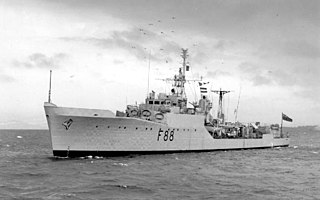
HMS Malcolm was a Blackwood-class, one of a dozen second-rate anti-submarine frigates built for the Royal Navy in the 1950s. She was commissioned on 12 December 1957 and decommissioned in 1978. She was the second Royal Navy ship to be bear the name, and was named after Admiral Sir Pulteney Malcolm, who served during the French Revolutionary and Napoleonic Wars.
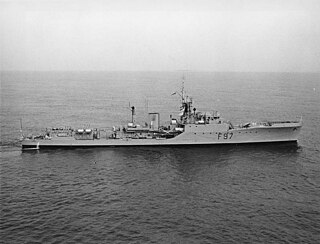
HMS Russell was one of a dozen Blackwood-class frigates of second-rate anti-submarine frigates built for the British Royal Navy during the 1950s. She was named for Edward Russell, 1st Earl of Orford, commander at the Battle of Barfleur in 1692.

HMS Londonderry was a Rothesay- or Type 12-class anti-submarine frigate of the British Royal Navy in service from 1960 to 1984.

HMS Eastbourne was a Whitby-class, or Type 12, anti-submarine frigate of the Royal Navy of the United Kingdom.
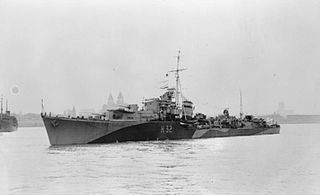
HMS Rapid was an R-class destroyer of the Royal Navy that saw service during the Second World War and was sunk as a target in 1981.

HMS Rocket was an R-class destroyer of the Royal Navy that saw service during Second World War. Built by Scotts Shipbuilding and Engineering Company in Greenock, Scotland, she was launched in October 1942 and commissioned in August 1943.

HMS Ulster was a U-class destroyer of the Royal Navy of the United Kingdom that saw service during World War II. She was later converted into a Type 15 fast anti-submarine frigate, with the new pennant number F83. Ulster was the second vessel in Royal Navy history to have that name.
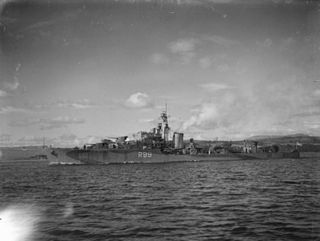
HMS Urchin was a U-class destroyer of the British Royal Navy that saw service during the Second World War.

HMS Wakeful was a W-class destroyer of the Royal Navy launched in 1943. She saw service during the Second World War and was later converted into a Type 15 fast anti-submarine frigate. She was sold for scrap in 1971.

HMS Token was a British submarine of the third group of the T class. She was built as P328 at Portsmouth Dockyard, and launched on 19 March 1943. So far she has been the only ship of the Royal Navy to bear the name Token.
In 1989 the Royal Navy was under the direction of the Navy Department in the UK Ministry of Defence. It had two main commands, CINCFLEET and Naval Home Command.
